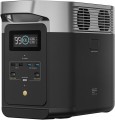Add to comparison |  |  |
|---|---|---|
| Choetech BS006 | EcoFlow DELTA 2 | |
from $1,179.36 | Compare prices 4 | |
| User reviews | ||
| TOP sellers | ||
2 USB A ports, 2 USB A QC3.0 ports, 2 USB C ports. Car cigarette lighter, 2 DC5521 ports. LiFePo4 battery 1997 Wh. | 2 USB A ports, 2 USB A Fast Charge ports, 2 USB C ports. Car cigarette lighter port DC5521. Jumps up to 2700 W are allowed. X-Stream port for fast charging (2200 W). LFP (LiFePO4) – lithium iron phosphate battery. | |
| In box | charging station | charging station |
| Rated power | 2000 W | 1800 W |
| Peak power | 2700 W | |
| Output waveform | sinusoid (PSW) | sinusoid (PSW) |
| UPS function | ||
Outputs | ||
| Sockets (230 V) | 3 | 4 |
| USB A | 2 5В/2.4А 12 W | 2 5В/2.4А 12 W |
| USB A (quick charge) | 2x QC3.0 18 W | 2 5В/2.4A, 9В/2A, 12В/1.5A 18 W |
| USB C | 2 5 A 100 W | 2 5 A 100 W |
| Car cigarette lighter | ||
Inputs (station charging) | ||
| From solar panels | ||
| Input port XT60 | ||
| Anderson port | 11.5 – 50 H / 500 W | |
| Add. ports | C13/14 (charging) | |
Battery and charging time | ||
| Connecting an additional battery | ||
| Battery type | LiFePO4 | LiFePO4 |
| Battery capacity | 1997 W*h | 1024 W*h |
| Charging cycles | 3000 | |
| Charging time (socket) ≈ | 120 min | 80 min |
| Charging time (solar panel) ≈ | 300 min | 180 min |
| Charging power (socket) | 1100 W | 1200 W |
| Charging power (solar panel) | 500 W | 500 W |
General | ||
| Smartphone synchronization | Bluetooth and WiFi | |
| PSU | built into the body | |
| Display | ||
| Backlight | ||
| Carrying handle | ||
| Operating temperature | -10 °C ~ +40 °C | 0 °C ~ +45 °C |
| Dimensions | 386x275x306 mm | 281x211x400 mm |
| Weight | 22 kg | 12 kg |
| Warranty | 2 years | 5 years |
| Added to E-Catalog | january 2023 | october 2022 |
Choetech BS006 and EcoFlow DELTA 2 are powerful charging stations, but they have their own features. Choetech BS006 offers a nominal power of 2000 W and 3 230 V outlets, as well as 4 USB ports, including QC3.0. Charging time from an outlet is about 120 minutes, and from a solar panel — 300 minutes. Meanwhile, EcoFlow DELTA 2 has a slightly lower nominal power of 1800 W, but supports a peak power of up to 2700 W and offers 4 230 V outlets. Charging time from an outlet for DELTA 2 is only 80 minutes, making it faster in this regard. Additionally, EcoFlow has a built-in power supply and the ability to sync with a smartphone via Bluetooth and Wi-Fi, which can be convenient for users. Overall, Choetech BS006 is better suited for long-term use with a large number of outputs, whereas EcoFlow DELTA 2 stands out for its fast charging and additional features.